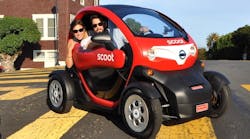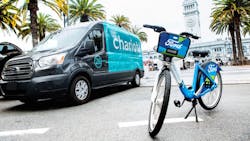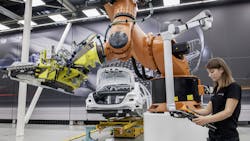Although the U.S. automotive industry saw record sales in 2016, the mood of its leaders right now is low-key, even a bit anguished. Gains that OEMs made after the Great Recession have slowed to a near-halt, with predicted sales for 2016 hovering around last year’s numbers, then dipping slightly in 2017.
Wall Street wants growth, and automotive manufacturers, realizing that they can’t rest on their SUV and pickup-truck laurels, are looking for it in uncharacteristic places. Nissan is partnering with an electric scooter company in San Francisco. Volkswagen wants to focus more on car-sharing and introduce up to 30 new electric vehicle models. General Motors has a vice president of urban mobility who recently told an auditorium full of automotive executives that in New York City, where she lives, “the whole idea of owning a car, parking it for $1,000 a month, and not using it 95% of the time is ludicrous.”
"Everything about our business is changing,” Bill Ford, avuncular executive chairman of Ford Motor Co. and great-grandson of Henry, told a potpourri of Detroit automotive beat reporters, soccer-mom and fashion bloggers, radio hosts and foreign journalists at his company’s trend conference in September. “It’s been a tough time for the auto industry because Wall Street doesn’t have a whole lot of faith in [us]."
Ford said some investment firms see auto companies as flatlining now that they’ve ridden a crest of post-recession growth. Or, they adopt the attitude that “with all this disruption, it’s not clear to us who’s going to win—what any [automotive companies] are going to look like in five years—so we’re just going to take a step back.”
More disruption is going on in automotive now than at any time since cars replaced horses as the dominant mode of long-distance transportation: After a long incubation period limited to annual DARPA challenges and whatever Google was doing in Mountain View, self-driving cars are on the fast track. Tech companies are muscling in on the traditional auto space. New mobility services like ride-hailing and microtransit are challenging the individual car ownership model.Meanwhile, the price of cars is outpacing wages in the United States, and political uncertainty and economic stagnancy are slowing growth in some emerging markets. Electric and fuel-cell vehicles are gaining traction as their price tags come down and range goes up (along with fuel economy standards).
The auto industry has to think about all this and the Volkwagen emissions cheating scandal and finding tech-savvy people to run the factories and software engineers to design algorithms to tell a driverless car how to behave when a herd of cattle is crossing the road.
“It’s not clear where some of these business opportunities really are,” Bill Ford said. “We are going to try a lot of different things, and obviously we have to build business models around them that work, and I’m very confident that that will happen.”
Until then: stay tuned for a considerable bit of rooting around in the dark.
Taking the Slow Road
Automakers looking for meaningful growth aren’t likely to find it in the United States. Vehicle prices have been growing faster than wages, observes Patrick Manzi, senior economist for the National Automobile Dealers Association. Consumers are stretched: car payments made up 12% of personal income in 2014—higher than the previous nine years. And the loans take longer to pay off: 67 months in 2015, compared to an average 54 months two decades ago.
Paul Traub, senior business economist for the Federal Reserve of Chicago, says that automotive sales likely peaked in 2015. Some of the reasons he sees include a trend since 2010 of Americans saving more of their income; a depletion of pent-up demand for new vehicles after the Great Recession; shortened commutes for more people working remotely from home; and a shift in population from smaller cities and suburbs to “megacities” where mass transportation is convenient. People are also holding onto their new vehicles longer: from an average 50 months in 2005 to 77.8 months in 2015.
Even in the richest metro area in the country, San Jose, Calif., a median-income household cannot afford the average new vehicle, says Bankrate’s 2016 Car Affordability Study.
Worldwide, car ownership climbs when average incomes hit the range of $5,000 to $20,000, says Gary Silberg, lead automotive industry partner for KPMG. Within that range, ownership leaps from one car per 10 people to one per two.
China is in that sweet spot for growth, but hurdles include car quotas in pollution-wracked major cities and regulations that require foreign automotive companies to partner with Chinese companies (and share their research).
India has huge potential, with about one car for every 30 people. But wages aren’t high enough.
“If you talk to the auto guys, every 10 years they say India will be 10 years away,” says Silberg. “It’s a low-end, $10,000 vehicle market—kind of a nuts and bolts market,” with the modest profit margins to match.
So where will the growth come from? If you subscribe to the iPhone theory that new features = people dashing to turn in their old products and buy new products quickly, then leaps in technology could benefit automakers. And if the self-driving, living-room-on-wheels models cost way too much for all but the wealthiest consumers, then replacing individual ownership with fleet-owned vehicles to share, hail and rent looks better and better.
Going Mobile
In the United States, Millennials with above-average earnings and education are the most frequent users of new mobility services like Uber, Lyft and Zipcar. They’re also the demographic that automakers want to sell their new cars to, but aren’t selling to in the numbers that they’d like. New mobility users own just over one car per household, compared to the national average of two, according to a 2016 study by the Center for Automotive Research.
So automakers are trying to figure out another way to get a piece of the action. Just this year: General Motors invested $500 million in Lyft. Ford partnered with bike-sharing startup Motivate, launched an on-demand bus-sharing service in Kansas City with a startup called Bridj and bought a microtransit company, Chariot. Toyota has invested in Uber, Volkswagen in Uber rival Gett.Automakers are “in the phase of experimenting with different business models and trying to define what could be their role beyond manufacturing vehicles and selling them through dealers,” said Adela Spulber, a transportation systems analyst at CAR and the lead author on the study. “It’s a time for repositioning, reinventing what it means to be an automaker in the 21st century.”
It’s a good time to experiment—throw some money around and see where it lands, because new mobility is still something of a distant threat. It’s still cheaper to own a car in the U.S. than to rely on mobility services, notes Spulber. That could change if a well-funded company like Uber is able to replace its drivers with autonomous technology and substantially lower the cost of a ride.
U.S. communities “are still structured in a way that makes the private automobile one of the most if not the most viable means of transportation,” says Spulber.
It’s less viable in China, with its quotas on vehicle ownership, and Europe, where there is more acceptance of shared mobility, more dependence on mass transit and more ambitious emissions agendas.
Ford started investing in mobility solutions back in 2007, when rudimentary parking, payment and municipal-ticking solutions “were about the only options out there.” Now, however, “the number of entrepreneurs and amount of money coming into mobility is very exciting.” But he’s not sure “how it’s going to shake out.” He doesn’t see robust business models surfacing yet, “as opposed to interesting experiments and things that are kind of cool but we’ll never make money on it.”
Not Your Grandma’s Technology?
At the trends conference, Ford’s chief technology officer, Raj Nair, wryly admitted to being “constantly terrified” by the disruption in his industry. “But paranoia can be good,” he said.
“In 1987, when I started as an engineer, I never thought someday I’d be test-driving a Ford GT, and on the same day I’d be getting into an autonomous vehicle. It’s one thing to make the technology available; it’s different to bring it to scale. Looking back, I’m sure this will be the highlight of a lot of our careers.”
After his talk, Ford engineers took visitors around the company’s Dearborn campus in an autonomous test vehicle—a Ford Fusion retrofitted with LIDAR sensors and cameras. With the engineers “driving conservatively” by cupping their hands near the steering wheel, topping out at 25 mph and sitting at crosswalks long after pedestrians had made it to the other side, it was cutting-edge technology filtered through your grandma who still has her sparkly couch from 1952 encased in plastic in her living room. It was sort of charming, the earnest concern for keeping people safe.
Charming to some. Tasha Keeney, an analyst at investment firm ARK, sees a company that’s a year or two behind Google and Telsa in autonomous and artificial intelligence technology. If traditional automakers can’t pick up the pace in the software arena, she sees their role in the world diminishing.
“Fiat gave 100 cars to Google for its test vehicles,” she says. “That’s a hardware relationship. They’re becoming hardware manufacturers. Traditonally in other markets, hardware companies like Foxconn, for instance, don’t get the margins that the owners of the software and the algorithms do.”
Silberg doesn’t see it that way. “One of the clear things to us is those who know how to manufacture a car or a vehicle or the component of the vehicle are going to be in high demand because it’s really hard to do,” he says. “I think tech companies are figuring out that making the car and all the complexities and component parts and getting the supply chain right--this is not for the faint of heart. Traditional companies that do that are in good shape.
“The question then becomes what these vehicles might look like in the future, and the components within them, and where might those need to be manufactured. I don’t have any data that says anything would change.”
Bringing It
With electric and other alternate-fuel vehicles becoming more prevalent, automotive manufacturing plants will need to be extremely flexible, says Tom Kurfess, professor of mechanical engineering at Georgia Tech.
Instead of just changing up the color of the car on the line, or a radio or CD player, “it’s different engines, different powertrains. We’re changing up the heart of the car.”
The best plants are already up to the task, he says. “In the factory, if oil prices go up, or this happens or that happens, they come up with a new battery, it all gets integrated into the product and the factory shifts to take advantage of that. That’s where in particular U.S. industry is going to excel and be the major player in the next several decades.”Kurfess says that the OEM operations will continue to be systems integrators, but with more software integration. Small and medium-sized suppliers have already invested in the high-tech machinery they need. What they will have to work harder at is developing the workforce to make the best use of the technology. They’re already buying the high-end tools that have all sorts of capability. But the shops are using the tools “essentially the same way they used them back in the ‘70s.” They need to bring in recent graduates and engage them with the latest gaming interfaces.
At Georgia Tech, this year’s crop of freshmen are programming high-end processors with the software used for Lego Mindstorms. “It’s reformulating the programming of these things into something that the next generation of kids understand,” says Kurfess. “Instead of playing Xbox, they’re programming our 5X machine tools to make turbo blades.”
Until a year or two ago, says Bill Ford, tech companies were telling automakers that they were going to “end up being the handset. You’re just going to be low-margin assemblers of other people’s cool technology.”
But that conversation has shifted “to a realization that we do bring a lot of technology ourselves. And our knowledge of integrating that technology can be valuable.
“To build a vehicle with quality is a lot harder to do than people have thought.”






